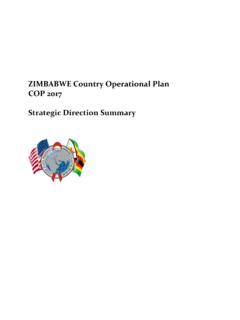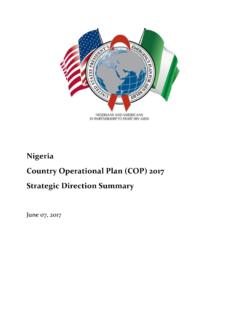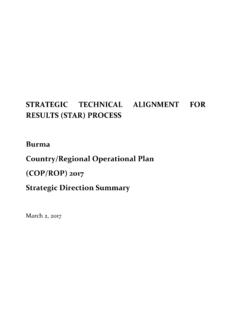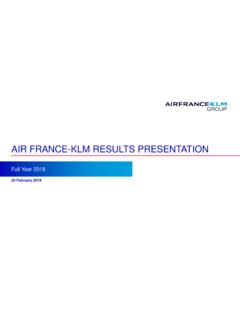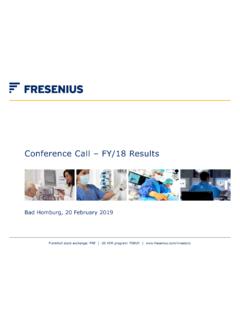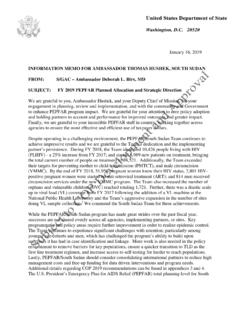Transcription of INFORMATION MEMO FOR AMBASSADOR MALAC, UGANDA …
1 January 16, 2019. INFORMATION MEMO FOR AMBASSADOR MALAC, UGANDA . FROM: S/GAC AMBASSADOR Deborah L. Birx, MD. SUBJECT: FY 2019 PEPFAR Planned Allocation and Strategic Direction We are grateful to you, AMBASSADOR Malac, and Deputy Chief of Mission Marcellin, for your engagement in planning, review and implementation, and with the community and Government to enhance PEPFAR program impact. We are grateful for your attention to core policy adoption and holding partners to account and performance for improved outcomes and greater impact. Finally, we are grateful to your incredible PEPFAR staff in country, working together across agencies to ensure the most effective and efficient use of taxpayer dollars. At the end of FY 2018, 1,168,228 were reported to be actively in treatment for HIV; a significant increase in treatment coverage measured by UPHIA just two years ago. With an investment of $4,130,005,889 from FY 2004 2019, the acceleration of people on treatment truly demonstrates the impact that can be achieved by rapidly adopting patient-centered policies and programs like test and start, multi-month drug dispensing and index testing.
2 In FY 2018, PEPFAR helped accelerate progress towards epidemic control by implementing the Surge for Quality, a focused effort to identify those living with HIV and ensure their rapid initiation onto treatment. This initiative included the roll out of index testing, assisted partner notification, and rapid initiation to treatment, as well as, expansion of multi-month scripting. As a result of these efforts, PEPFAR identified 282,041 PLHIV and initiated 229,184 on treatment. While these results fell short of annual targets, the incredible increase between the first and fourth quarters has put UGANDA on a trajectory to reach epidemic control. This year PEPFAR also expanded programs to prevent new infections. This included performing 586,167 voluntary medical male circumcisions (VMMC), enrolling 94,172 adolescent girls and young women (AGYW) into DREAMS, and initiating 8,527 individuals on PrEP. PEFPAR. UGANDA also provided services to 424,346 orphans and vulnerable children and their care givers.
3 While these results are promising, there is still significant work to reach epidemic control. The Surge for Quality was only implemented in approximately 1/3rd of PEPFAR sites and the programmatic lessons and quality improvements need to be expanded to the rest of UGANDA . Retention in treatment also remains a challenge and expansion of differentiated service delivery, including three to six months dispensing, and rapid transition to TLD will be essential to closing that gap. In addition, financial management of the program requires more intense focus, with 25. implementing mechanisms (IMs) expending more than 125% of their planned budgets in FY. 2018, and many more expending between 100-125% of their approved levels. USAID UGANDA outlaid $18M more than approved. Outlays and expenditures will be closely watched in FY. -2- 2019 and PEPFAR UGANDA may be required to cut future funding to any IMs continuing to spend in excess of approved levels. For the Country Operation Plan for 2019 (COP19), PEPFAR will need to continue to support UGANDA to close the remaining gaps to reaching epidemic control, ensuring that quality services are available for all populations throughout the country.
4 This will include finalizing the transition to TLD and ensuring TPT is brought to scale. PEPFAR will also need to begin evolving the program in attained districts from a scale up approach to one focused on maintenance of epidemic control, including case-based surveillance. The President's Emergency Plan for AIDS Relief (PEPFAR) total planning level for UGANDA for COP 2019 is $410,000,000, inclusive of all new funding accounts and applied pipeline. If you have questions about the priorities and guidance laid out in this letter, please contact your Chair and Program Manager. My office is continually grateful for your team's work on the PEPFAR program, helping us to move towards an AIDS-free generation by supporting the HIV. response in UGANDA . APPENDICES: 1. COP 2019 PLANNING LEVEL. 2. COP 2019 BUDGETARY REQUIREMENTS & GUIDANCE. 3. PAST PERFORMANCE. 4. COP 2019 DIRECTIVES. -3- APPENDIX 1: COP 2019 PLANNING LEVEL. Based upon current analysis of spend levels, INFORMATION submitted for the FY 2018 Q4 POART.
5 And performance INFORMATION , the total COP 2019 planning level is estimated to be comprised as follows: Table 1. COP 2019 Budget Table 2. Applied Pipeline**. All planning levels are subject to further adjustment, based upon appropriations, further analysis determining the availability of excessive pipeline, and other developments during the course of COP 2018 implementation and the COP 2019 review process. The total spend in the implementation of COP 2019 (FY 2020) may not exceed the total COP 2019 planning level of $410,000,000. Central Funding UGANDA is also receiving $189,294 in Central Funds as a part of the FBO Initiative. These FY. 2018 funds are being notified to you via this letter; however, note that these funds are being -4- released immediately, ahead of the release of the bilateral COP 2019 funds. Central Funds for the FBO Initiative should be used as soon as possible after receipt, during the current implementation cycle of COP 2018/FY 2019. Each country team should specify the purpose and use of these funds (based the data and analysis from the recent FBO TDYs) as part of the SDS.
6 -5- APPENDIX 2: COP 2019 BUDGETARY REQUIREMENTS. Table 3. COP 2019 Earmarks UGANDA COP 2019 EARMARK REQUIREMENTS. Care and Treatment (C&T) $ 191,964,960. % of base funds allocated to C&T 56%. HKID $ 27,423,566. Gender Based Violence (GBV) $ 4,704,843. Water $ 3,000,000. Care and Treatment: If there is no adjustment to the COP 2019 new funding level due to an adjustment in applied pipeline, UGANDA 's minimum requirement for the care and treatment earmark is reflected in the chart above. Your care and treatment requirement is calculated as the sum of total new FY 2019 funding programmed to the HTXS, HTXD, HVTB, HBHC, PDTX, PDCS budget codes, 30% of the total funding programmed to the MTCT budget code, 80% of the total funding programmed to the HLAB budget code, and 30% of the total funding programmed to the HVCT budget code. This minimum care and treatment earmark has been derived based upon a requirement that your country programs a minimum of 56% of all new FY. 2019 Base Funds to care and treatment of people living with HIV.
7 HKID Requirement: UGANDA 's COP 2019 minimum requirement for the HKID budget code is reflected in the chart above. Your COP 2019 HKID requirement is derived based upon the approved COP 2018 HKID level. The COP 2019 planned level of new funds for HKID can be above this amount; however, it cannot fall below it. Gender Based Violence (GBV): UGANDA 's COP 2019 minimum requirement for the GBV. earmark is reflected in the chart above. Your GBV earmark requirement is calculated as the total new FY 2019 funding programmed to the GBV cross-cutting code. Your COP 2019 earmark is derived by using the final COP 2018 GBV earmark allocation as a baseline. The COP 2019. planned level of new FY 2019 funds for GBV can be above this amount; however, it cannot fall below it. Water: UGANDA 's COP 2019 minimum requirement for the water earmark is reflected in the chart above. Your water earmark requirement is calculated as the total new FY 2019 funding programmed to the water cross-cutting code.
8 Your COP 2019 earmark is derived by using the final COP 2018 water earmark allocation as a baseline. The COP 2019 planned level of new FY. 2019 funds for water can be above this amount; however, it cannot fall below it. Transitioning HIV Services to Local Partners: To sustain epidemic control, it is critical that the full range of HIV prevention and treatment services are owned and operated by local institutions, governments, and organizations regardless of current ARV coverage levels. The intent of the transitioning to local partners is to increase the delivery of direct HIV services, along with non- direct services provided at the site, and establish sufficient capacity, capability, and durability of these local partners to ensure successful, long-term local partner engagement and impact. This -6- action is a priority for all OUs, Regional Programs and Country Pairs. PEPFAR has set a 70%. goal by agency by the end of FY20, and must meet 40% by FY19. Each country has to contribute to this goal based on the context of the local partner mix and types of public and private partners available to provide essential services.
9 Therefore, each UGANDA agency should work with their respective agency HQ in determining their contribution in meeting the agency level local partner requirement for FY20 as appropriate through their COP 2019 submission. COP 2019 Applied Pipeline All agencies in UGANDA should hold a 3 month pipeline at the end of COP 2019 implementation in order to ensure sufficient funds and prevent disruptions in service delivery in the event of funding delays. Any agency that anticipates ending COP 2018 implementation (end of FY 2019). with a pipeline in excess of 3 months is required to apply this excessive pipeline to COP 2019, decreasing the new funding amount to stay within the planning level. The Applied Pipeline amount of $67,205,429 given by S/GAC as a part of the COP 2019. planning level has been calculated to reflect the projected excessive pipeline as of the beginning of the COP 2019 implementation cycle (FY 2020), and is the minimum amount that UGANDA must apply as pipeline in the COP 2019 submission.
10 The distribution of new base funds and Applied Pipeline was calculated to ensure 3 months of pipeline remains with mechanisms, based upon the financial data submitted for the FY 2018 Q4 Obligation and Outlay and FY 2018 End of Fiscal Year (EOFY) reports. Expired funds, funds on expired mechanisms and projected FY. 2019 outlays as submitted in the EOFY report were all taken into consideration to inform the projected excessive pipeline and the required COP 2019 applied pipeline amount. Unliquidated obligations on closed mechanisms identified in the FY 2018 EOFY report should be de-obligated in a timely manner. This will continue to be monitored throughout FY 2019. (COP 2018 implementation) and into COP 2019. APPENDIX 3: PAST PERFORMANCE TRENDS. Table 4. COP 2017/ FY 2018 Outlays versus Approved Budget Sum of Approved COP Sum of total FY 2018 Sum of Over/Under Agencies 2017 Planning Level Outlays Outlays UGANDA Total $ 385,239,274 $ 397,205,960 $ 11,966,686. HHS $ 208,839,987 $ 192,691,596 $ (16,148,391).

